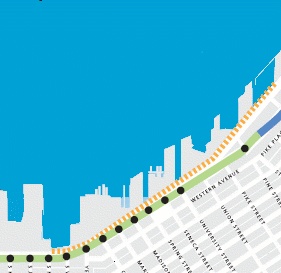While the People’s Waterfront Coalition wants a boulevard as a stick to reduce demand by inducing gridlock, that is certainly not the only way a boulevard could work. Beyond the flip, a boulevard concept that retains capacity while maintaining a vibrant waterfront.
To maintain capacity in this key corridor, six lanes are a necessity. WSDOT studied a six lane surface option as part of the original Alaskan Way Environmental Impact Statement.

This alternative performed poorly. Little surprise, as it has twelve signalized intersections on the waterfront. Even six lanes cannot move traffic quickly with a traffic light every block.
With the rebuild and tunnel alternatives, we retain about the same access points to downtown we have now, one northbound offramp and one southbound onramp. Why must the surface alternative provide access to every single intersecting street? It strikes me as a choice made in pursuit of making this option look bad.
Here is a conceptual vision of a boulevard designed to move traffic swiftly while maintaining good access to downtown. (click for full size)
With the addition of two elevated ramps, access is provided to Spring and from Madison to the southbound roadway. The existing Seneca northbound exit is maintained, and a new exit is added at Marion. A short overpass creates a full interchange at Jackson, and provides improved ferry terminal access. No at-grade intersections or traffic lights are created on 99.
A series of pedestrian bridges connects the waterfront promenade to downtown at Pike, Union, University & Columbia. They would descend to the promenade just west of the roadway via grand staircases and elevators. (click for full size)
The last critical component of this concept is the noise wall seperating the boulevard and promenade. A precast 15 foot wall ensures a quiet waterfront, with appropriate landscaping along the promenade side to soften the visual impact.
A bike path is provided as part of the promenade, as well as a one-way frontage road for deliveries. The Waterfront Streetcar moves to Western Ave, with stops located at each pedestrian bridge.
While this alternative does not provide the fancy waterfront created by a tunnel, it would move the same amount of traffic as the Viaduct, without any traffic lights. The average speed might be a little lower than the elevated option, but this boulevard would disperse traffic into the downtown grid better with more exits.
Something to think about next time someone tells you a boulevard would inevitably create gridlock…


